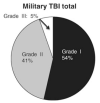The Boston Assessment of Traumatic Brain Injury-Lifetime (BAT-L) semistructured interview: evidence of research utility and validity
- PMID: 23535389
- PMCID: PMC3997066
- DOI: 10.1097/HTR.0b013e3182865859
The Boston Assessment of Traumatic Brain Injury-Lifetime (BAT-L) semistructured interview: evidence of research utility and validity
Abstract
Objective: Report the prevalence of lifetime and military-related traumatic brain injuries (TBIs) in Operation Enduring Freedom and Operation Iraqi Freedom (OEF/OIF) veterans and validate the Boston Assessment of TBI-Lifetime (BAT-L).
Setting: The BAT-L is the first validated, postcombat, semistructured clinical interview to characterize head injuries and diagnose TBIs throughout the life span.
Participants: Community-dwelling convenience sample of 131 OEF/OIF veterans.
Design: TBI criteria (alteration of mental status, posttraumatic amnesia, and loss of consciousness) were evaluated for all possible TBIs, including a novel evaluation of blast exposure.
Main measures: BAT-L, Ohio State University TBI Identification Method (OSU-TBI-ID).
Results: About 67% of veterans incurred a TBI in their lifetime. Almost 35% of veterans experienced at least 1 military-related TBI; all were mild in severity, 40% of them were due to blast, 50% were due to some other (ie, blunt) mechanism, and 10% were due to both types of injuries. Predeployment TBIs were frequent (45% of veterans). There was strong correspondence between the BAT-L and the OSU-TBI-ID (Cohen κ = 0.89; Kendall τ-b = 0.95). Interrater reliability of the BAT-L was strong (κs >0.80).
Conclusions: The BAT-L is a valid instrument with which to assess TBI across a service member's lifetime and captures the varied and complex nature of brain injuries across OEF/OIF veterans' life span.
Figures


Similar articles
-
Correspondence of the Boston Assessment of Traumatic Brain Injury-Lifetime (BAT-L) clinical interview and the VA TBI screen.J Head Trauma Rehabil. 2015 Jan-Feb;30(1):E1-7. doi: 10.1097/HTR.0000000000000008. J Head Trauma Rehabil. 2015. PMID: 24336147 Free PMC article.
-
The Boston Assessment of Traumatic Brain Injury-Lifetime Semistructured Interview for Assessment of TBI and Subconcussive Injury Among Female Survivors of Intimate Partner Violence: Evidence of Research Utility and Validity.J Head Trauma Rehabil. 2022 May-Jun 01;37(3):E175-E185. doi: 10.1097/HTR.0000000000000700. Epub 2021 Jun 15. J Head Trauma Rehabil. 2022. PMID: 34145160
-
Deployment-related TBI, persistent postconcussive symptoms, PTSD, and depression in OEF/OIF veterans.Rehabil Psychol. 2011 Nov;56(4):340-50. doi: 10.1037/a0025462. Rehabil Psychol. 2011. PMID: 22121940 Free PMC article.
-
Psychological Stress-Induced Immune Response and Risk of Alzheimer's Disease in Veterans from Operation Enduring Freedom and Operation Iraqi Freedom.Clin Ther. 2020 Jun;42(6):974-982. doi: 10.1016/j.clinthera.2020.02.018. Epub 2020 Mar 14. Clin Ther. 2020. PMID: 32184013 Free PMC article. Review.
-
Acute Pathophysiology of Blast Injury—From Biomechanics to Experiments and Computations: Implications on Head and Polytrauma.In: Kobeissy FH, editor. Brain Neurotrauma: Molecular, Neuropsychological, and Rehabilitation Aspects. Boca Raton (FL): CRC Press/Taylor & Francis; 2015. Chapter 18. In: Kobeissy FH, editor. Brain Neurotrauma: Molecular, Neuropsychological, and Rehabilitation Aspects. Boca Raton (FL): CRC Press/Taylor & Francis; 2015. Chapter 18. PMID: 26269922 Free Books & Documents. Review.
Cited by
-
Future thinking in PTSD: Preliminary evidence for altered event construction.Psychiatry Res. 2024 Mar;333:115768. doi: 10.1016/j.psychres.2024.115768. Epub 2024 Feb 2. Psychiatry Res. 2024. PMID: 38325161
-
Neurobiological indicators of disinhibition in posttraumatic stress disorder.Hum Brain Mapp. 2015 Aug;36(8):3076-86. doi: 10.1002/hbm.22829. Epub 2015 May 9. Hum Brain Mapp. 2015. PMID: 25959594 Free PMC article.
-
Close-range blast exposure is associated with altered functional connectivity in Veterans independent of concussion symptoms at time of exposure.Hum Brain Mapp. 2015 Mar;36(3):911-22. doi: 10.1002/hbm.22675. Epub 2014 Nov 4. Hum Brain Mapp. 2015. PMID: 25366378 Free PMC article.
-
Interpersonal early-life trauma alters amygdala connectivity and sustained attention performance.Brain Behav. 2017 Apr 10;7(5):e00684. doi: 10.1002/brb3.684. eCollection 2017 May. Brain Behav. 2017. PMID: 28523226 Free PMC article.
-
PTSD modifies performance on a task of affective executive control among deployed OEF/OIF veterans with mild traumatic brain injury.J Int Neuropsychol Soc. 2013 Aug;19(7):792-801. doi: 10.1017/S1355617713000544. Epub 2013 Jul 3. J Int Neuropsychol Soc. 2013. PMID: 23823533 Free PMC article.
References
-
- Vasterling JJ, Brailey K, Proctor SP, Kane R, Heeren T, Franz M. Neuropsychological outcomes of mild traumatic brain injury, posttraumatic stress disorder and depression in Iraq-deployed US Army soldiers. Br J Psychiatry. 2012;201(3):186–192. - PubMed
-
- Hoge CW, McGurk D, Thomas JL, Cox AL, Engel CC, Castro CA. Mild traumatic brain injury in U.S. soldiers returning from Iraq. N Engl J Med. 2008;358(5):453–463. - PubMed
-
- Terrio HP, Nelson LA, Betthauser LM, Harwood JE, Brenner LA. Postdeployment traumatic brain injury screening questions: sensitivity, specificity, and predictive values in returning soldiers. Rehabil Psychol. 2011;56(1):26–31. - PubMed
-
- Schell T, Marshall G, Tanielian T, Jayox L, editors. Invisible Wounds of War: Psychological and Cognitive Injuries, Their Consequences, and Services to Assist Recovery. Vol 4. RAND; Santa Monica, CA: 2008. Survey of individuals previously deployed for OEF/OIF; pp. 87–116.
-
- Schneiderman AI, Braver ER, Kang HK. Understanding sequelae of injury mechanisms and mild traumatic brain injury incurred during the conflicts in Iraq and Afghanistan: persistent postconcussive symptoms and posttraumatic stress disorder. Am J Epidemiol. 2008;167(12):1446–1452. - PubMed
Publication types
MeSH terms
Grants and funding
LinkOut - more resources
Full Text Sources
Other Literature Sources
Research Materials

